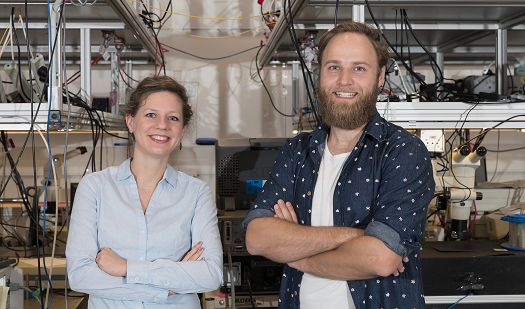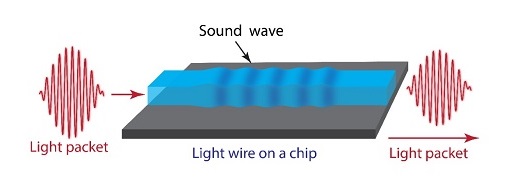Researchers at the University of Sydney have produced a photonic microchip that slows down the transmission of digital information by converting light signals into acoustic waves, enabling the chip to briefly store and manage the data before further transmitting it again as light. The work has been published in Nature Communications.

University of Sydney researchers Moritz Merklein and Dr Birgit Stiller (Credit: Louise Connor)
The speed of light poses a challenge for companies such as IBM and Intel who are pursuing light-based computing, as the rate of data transmission it offers is currently too fast for modern microchip technology to process.
The rate of data transmission must therefore be slowed within photonic microchips in order for the information to be usable, and ultimately for the devices to become commercially viable.
To achieve this, University of Sydney researchers Moritz Merklein and Dr Birgit Stiller, at the ARC Centre of Excellence for Ultrahigh bandwidth Devices for Optical Systems (CUDOS), have developed a photonic microchip with a memory that coherently transfers digital information between light waves and acoustic signals. The resulting difference in transmission speed causes enough of a delay for the digital information to be interpreted by the chip.
‘The information in our chip in acoustic form travels at a velocity five orders of magnitude slower than in the optical domain,’ explained Stiller. ‘It's like the difference between thunder and lightning.’
The reduction in speed caused by the acoustic signal enables the information to be held on the chip for an extra 10 nanoseconds, enough delay for it to be processed more effectively. ‘Building an acoustic buffer inside a chip improves our ability to control information by several orders of magnitude,’ Merklein confirmed.

Basic principle: light enters the microchip and is stored briefly as an acoustic wave before propagating again as light. (Credit: University of Sydney)
The new chip was fabricated out of chalcogenide glass, a material that provides optimal guidance of both optical and acoustic waves. The chip's optical acoustic memory system is able to operate at room temperature and can be interfaced with other on-chip components in a straight forward manner, meaning it can be easily integrated into photonic circuits. This could eliminate electronic processing steps to some extent, and could potentially lead to a paradigm shift in processing technology.
‘This is an important step forward in the field of optical information processing as this concept fulfils all requirements for current and future generation optical communication systems,’ commented co-author Professor Benjamin Eggleton, director of CUDOS.
The new chip could have applications in telecommunications, optical fibre networks and cloud computing data centres, where traditional electronic micro-chips are susceptible to electromagnetic interference, produce too much heat or use too much energy. The new chip is also not limited to a narrow bandwidth, unlike previous systems, and therefore allows information to be stored and retrieved at multiple wavelengths simultaneously, vastly increasing its efficiency.
‘The transfer of information from light to acoustic phonons is an exciting area currently receiving a lot of attention worldwide, and we hope this work will stimulate some new on-chip information processing capabilities,’ commented CUDOS chief investigator associate professor Steve Madden, whose team fabricated the chip at the Australian National University’s Laser Physics Centre – also part of the CUDOS Centre of Excellence.

